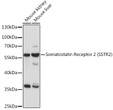| Tissue Specificity | Expressed in both pancreatic alpha- and beta-cells (at protein level). Expressed at higher levels in the pancreas than other somatostatin receptors. Also expressed in the cerebrum and kidney and, in lesser amounts, in the jejunum, colon and liver. In the developing nervous system, expressed in the cortex where it is located in the preplate at early stages and is enriched in the outer part of the germinal zone at later stages. In the cerebellum, expressed in the deep part of the external granular layer at gestational week 19. This pattern persists until birth but disappears at adulthood. |
| Post Translational Modifications | Phosphorylated on serine and threonine residues in response to agonist stimulation, leading to receptor desensitization and rapid internalization. Phosphorylated to a greater extent on serine than threonine residues. Threonine phosphorylation is required for arrestin binding and receptor endocytosis but is not necessary for desensitization. |
| Function | Receptor for somatostatin-14 and -28. This receptor is coupled via pertussis toxin sensitive G proteins to inhibition of adenylyl cyclase. In addition it stimulates phosphotyrosine phosphatase and PLC via pertussis toxin insensitive as well as sensitive G proteins. Inhibits calcium entry by suppressing voltage-dependent calcium channels. Acts as the functionally dominant somatostatin receptor in pancreatic alpha- and beta-cells where it mediates the inhibitory effect of somatostatin-14 on hormone secretion. Inhibits cell growth through enhancement of MAPK1 and MAPK2 phosphorylation and subsequent up-regulation of CDKN1B. Stimulates neuronal migration and axon outgrowth and may participate in neuron development and maturation during brain development. Mediates negative regulation of insulin receptor signaling through PTPN6. Inactivates SSTR3 receptor function following heterodimerization. |
| Protein Name | Somatostatin Receptor Type 2Ss-2-RSs2-RSs2rSst2Srif-1 |
| Database Links | Reactome: R-HSA-375276Reactome: R-HSA-418594 |
| Cellular Localisation | Cell MembraneMulti-Pass Membrane ProteinCytoplasmLocated Mainly At The Cell Surface Under Basal ConditionsAgonist Stimulation Results In Internalization To The Cytoplasm |
| Alternative Antibody Names | Anti-Somatostatin Receptor Type 2 antibodyAnti-Ss-2-R antibodyAnti-Ss2-R antibodyAnti-Ss2r antibodyAnti-Sst2 antibodyAnti-Srif-1 antibodyAnti-SSTR2 antibody |
Information sourced from Uniprot.org












